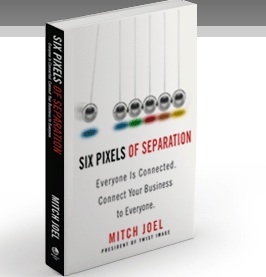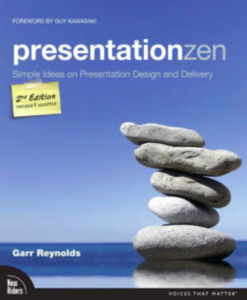Over the next few weeks, we’re reading Mitch Joel‘s Six Pixels of Separation in my writing classes at Rider University.  The following post is Part 1 of a two-part study guide I’ve pulled together for my students. Next week, I’ll be posting Part 2 here, as well. If you’re interested in learning more about digital/online communication and marketing, I think you’ll love this book as much as I do. 🙂
The following post is Part 1 of a two-part study guide I’ve pulled together for my students. Next week, I’ll be posting Part 2 here, as well. If you’re interested in learning more about digital/online communication and marketing, I think you’ll love this book as much as I do. 🙂
Here’s the study guide:
—
I’ve written this study guide to help you connect with the main concepts Mitch Joel writes about in his book, Six Pixels of Separation. I hope Mitch’s book and this guide help you gain:
- a better understanding of the digital marketing/communications era we live in today
- and an appreciation of just how much online communication has transformed our world, in general.
My goal in asking you to read this book (and one of Mitch’s goals in writing the book) is to help you to see the power offered by digital communications and the online world, a world where distance is not an issue, and a world where we are easily connected to each other asynchronously and in real time.
This study guide was created for my COM106 students. In our class, there will be two quizzes on Six Pixels of Separation:
- QUIZ #1 on September 24th will cover the Introduction and Chapters 1-6. (Review Part 1 of this study guide to prepare for Quiz #1.)
- QUIZ #2 on October 1st will cover Chapters 7-14. (Review Part 2 of this study guide to prepare for Quiz #2.)
The book’s Introduction:
Don’t skip reading the introduction because it gives us the opportunity to learn how this book came about, and to see how successful we can be as writers/bloggers today because of online communication channels (blogs, social media, etc.). Mitch writes, “All of my past and current personal successes in life, from the growth of Twist Image to the mass media attention to the publishing deal that put this book in your hands, has been because of these online channels…”(p. xi) According to Mitch (and I agree with him), the digital communication channels offer many opportunities to us. They’re not the “time suck” that many people accuse them of being…
Chapter 1: I Google You… Just Like You Google Me
Understand key concepts/terms from this chapter: transparency, personal branding, community, online community, networking, social media, blogging.
“Being able to publish to the world for free is a big (huge) deal… what we’re really seeing is an entirely new marketing and communications channel emerge where brands are all treated equally (sometimes equally badly, sometimes equally well)… We’re seeing a new world where people are building huge networks of connections that foster community, conversation and commerce.”
Review the “Six Social Needs” (pp. 19-20). Among them: “Online social networks provide people with the ultimate tool for defining and redefining themselves, as evidenced in profile pages on Facebook…” – research findings originally from Center for Media Research e-newsletter (December 2007).
Chapter 2: The Trust Economy
Understand key concepts/terms from this chapter: trust economy, participatory culture, authenticity, channels, permission, content, blog, micro-blog, podcast, online social network, sharing sites, user-generated content, wiki, widgets, consistency
“When you engage in a conversation and treat your consumers with respect and as your peers, magical things will happen.” (p. 26)
“You are in the business of building your own trust economy as part of your core values and foundation.” (p. 27)
“The two pillars for building your business through the digital channels will be: Permission… Content…” (p. 27)
“Speak like a human being, not like a press release.” (pp. 42-43)
Chapter 3: Entrepreneurship
In this chapter, focus on pages 52-53 where Mitch lists the qualities of a great website.
Chapter 4: Faith-Based Initiatives, Viral Expansion Loops and the Long Road
Understand key concepts/terms from this chapter: online communities, engagement, participation
(This chapter contains a lot of conceptual information. Read it for your own benefit, but you won’t be quizzed on any details from this chapter.)
Chapter 5: Know Control
Understand key concepts/terms from this chapter: blogging, subject-matter experts, Arianna Huffington, Huffington Post
“When blogging first made its debut (around 2000), most journalists and mass media people denounced it… Around 2004 more and more newspapers began quoting bloggers as subject-matter experts… Suddenly, the words of bloggers carried as much weight as (and sometimes more than) those of the mainstream media.” (p. 90)
“Your company’s newest challenge is speed – how fast do you move?… In a world of publishing platforms like YouTube and Twitter where the consumer is in (and sometimes out of) control of creating content, that’s getting harder and harder to do.” (p. 93)
“Get comfortable with being a little uncomfortable. The new business game is not about control. It’s about the volume of voices…” (p. 95)
“Resign your privacy. Yes, you’re naked on the Internet… The general rules of thumb are: Be smart, be very self-aware, and always think about the content your are creating and putting out there as a lasting record of yourself.” (p. 98)
“It’s not just about the Internet: Think mobile too.” (p. 103)
Chapter 6: The Real World
(This chapter has a lot of interesting information about “unconferences” and meet-ups… I think the key message you should take away from this chapter (at this point in your lives) is that there will always be value in meeting face-to-face with other people. Communication in the online channels should never replace in-person communication.)
###
Part 2 of this study guide will be published on this blog next week. If you have any questions or want to discuss some of the concepts Mitch Joel writes about in Six Pixels of Separation, please comment here. Thanks!
Additional resources:
Are Six Pixels of Separation All That Keeps Us Apart? by Bryan Eisenberg, published September 8th, 2009 – http://www.grokdotcom.com/2009/09/08/are-six-pixels-of-separation-all-that-keeps-us-apart/
A Summary of Six Pixels of Separation from PolarUnlimited.com –http://www.polarunlimited.com/2009/09/business-book-summary-18-six-pixels-of-separation-by-mitch-joel/
Six Pixels of Separation – The Blog by Mitch Joel: http://www.twistimage.com/blog/
 Are your business presentations “Zen-like”? In his book, Presentation Zen, Garr Reynolds describes exactly what this means. (Side note: I originally discovered the first edition of this book years ago in my own personal quest to improve my business presentations and guide my clients in doing the same. But I instantly added Presentation Zen to the required reading list for one of the courses I teach at Rider University, too.) Sharing this book and the concepts Garr covers in the book with current and future business professionals is my attempt — in a very small way — to support Garr’s “mission” — and to hopefully help improve the quality of presentations in the business world, today and tomorrow.
Are your business presentations “Zen-like”? In his book, Presentation Zen, Garr Reynolds describes exactly what this means. (Side note: I originally discovered the first edition of this book years ago in my own personal quest to improve my business presentations and guide my clients in doing the same. But I instantly added Presentation Zen to the required reading list for one of the courses I teach at Rider University, too.) Sharing this book and the concepts Garr covers in the book with current and future business professionals is my attempt — in a very small way — to support Garr’s “mission” — and to hopefully help improve the quality of presentations in the business world, today and tomorrow.

